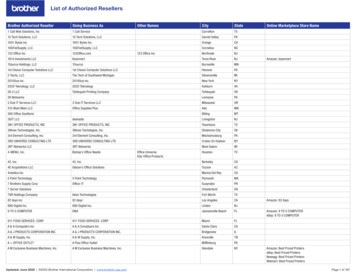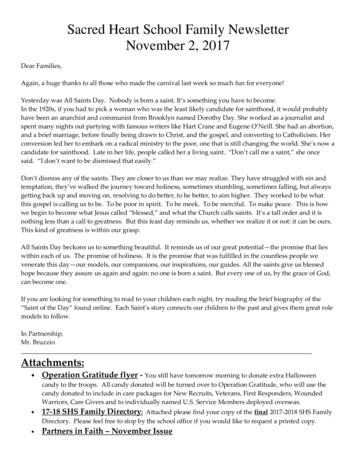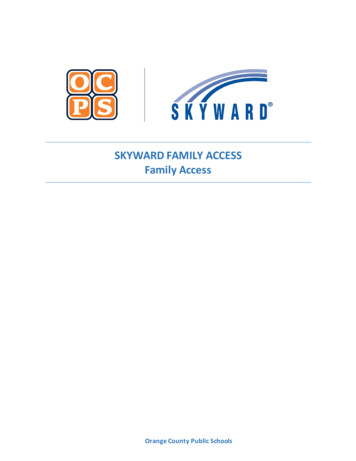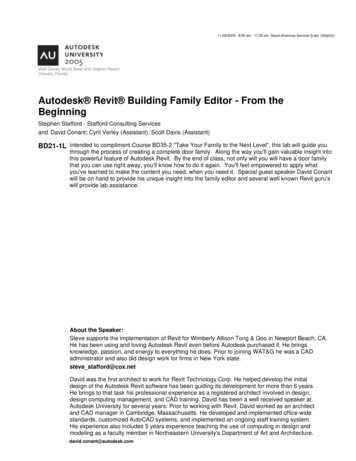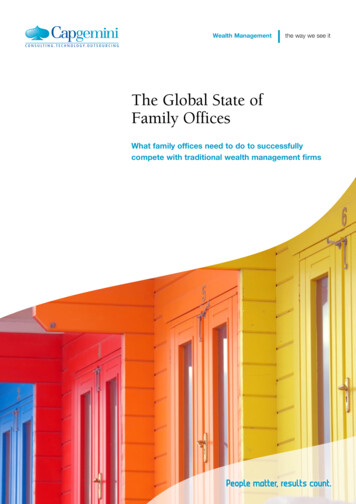
Transcription
Wealth Managementthe way we see itThe Global State ofFamily OfficesWhat family offices need to do to successfullycompete with traditional wealth management firms
Contents1. Introduction32. The Background on Family Offices42.1. Types42.2. Services Provided52.3. Benefits63. Growth Drivers and Trends3.1. Market Growth Drivers73.2. Ultra-HNWI Growth Drivers83.3. Regional Business Trends84. Challenges104.1. Regulatory Impact104.2. Operational Challenges114.3. Technological Issues125. Recommendations and Opportunities Ahead27135.1. Overcoming Current Challenges135.2. Key Opportunities Based on Future Outlook166. Conclusion17References18
the way we see it1. IntroductionA family office serves asa personal CFO to theultra wealthy, providinga disciplined approach intoday’s volatile markets tothe successful protection andgrowth of wealth.A family office is a private wealth management advisory firm that is established byan Ultra-HNWI1 to manage their family’s private wealth. Any firm that providesinvestment advice only to family members, is wholly owned and controlled byfamily members, and does not hold itself out to the public as an investment advisoris considered a family office2. However, a family office goes beyond just managingwealth. It also helps secure a family’s financial future by building, preserving, andtransferring family wealth and legacy.While early family offices can be traced to Europe, it was in the early 19th centurythat wealthy merchants along the east coast of the United States started hiringadvisors to protect their family interests. The demand for family office serviceskept growing as the number of Ultra-HNWIs increased over the years. Today,wealthy families rely on family offices for full time professional management oftheir personal fortune. The number of family offices in the U.S. has grown to about3,000 single-family offices3, with assets under management between 1 trillion and 1.2 trillion. There are also about 150 multi-family offices4 having assets undermanagement between 400 billion to 450 billion5.However, the growth of family offices has not gone unnoticed by private wealthmanagement firms who have started offering family-office type services for UltraHNWIs. This puts family offices directly in competition with private banks.However, in the wake of the financial crisis of 2007-09, Ultra-HNWIs have a fragilelevel of trust and confidence in banks, and increasingly prefer family offices. Familyoffices currently stand amid a landscape filled with opportunities to further expandtheir business. However, they are also struggling with regulatory, operational, andtechnological challenges which may slow down their growth. It therefore becomesimperative to understand these challenges and make business decisions that willhelp family offices emerge successfully in an environment of intense competitionwith private banks and other wealth management firms.12345The Global State of Family Offices“Ultra-HNWI” stands for an Ultra-high-net-worth individual who has over US 30 million in financial wealthU.S. Securities and Exchange CommissionA single-family office caters to the financial needs of a single familyA multi-family office caters to the financial needs of multiple familiesFamily Wealth Alliance (http://www.fwalliance.com/)3
2. The Background onFamily Offices2.1. TypesMulti-family offices often startoff as a single-family officecatering to an affluent family,but gradually evolve into amulti-family office as they beginaccepting clients beyond theimmediate family.Family offices are broadly classified as either single-family offices or multi-familyoffices. A single-family office is an organization that is created to support thefinancial needs of a specific family group. In general, a single-family office becomesaffordable for clients with at least 100 million or more of investable assets. Someof the billionaires who created single-family offices to manage their wealth includeJohn D. Rockefeller (the first American billionaire), George Soros, and more recentlyOprah Winfrey.A multi-family office is an organization that provides family office services to morethan one family group. It provides a similar range of customized services as areprovided by a single-family office but without the need to set up a separate familyoffice infrastructure. The service provided by a multi-family office therefore becomesaffordable for Ultra-HNWIs with wealth of about 50 million or even lower. Overtime, many single-family offices have grown into multi-family offices as they startedaccepting outside family clients. Examples of multi-family offices include Rockefeller& Co. which started in 1882 as a single family office but converted into a multifamily office in 1980, Bessemer Trust, and Wells Fargo Family Wealth, all of whichmanage the wealth of several affluent clients.Family offices can also be classified based on the range of services they provide.An administrative family office employs staff that provides bookkeeping,tax, and administrative services to the family. A hybrid family office providesadministrative, legal, and taxation advice, but outsources non-strategic functions. Afully-integrated family office provides administrative, tax, legal advice, and coreinvestment management functions.The following exhibit provides a comparative analysis of the range of assets requiredand the typical overhead costs involved in running family offices6:Exhibit 1: Family Office Types Based on Range of Assets and Overhead Costs7674AssetsOverhead Cost / YearAdministrative 50 million - 100 million 0.1 million - 0.5 millionHybrid 100 million - 1 billion 0.5 million - 2 millionFully Integrated 1 billion 1 million - 10 millionFamily Offices are typically private wealth management firms that maintain their client confidentiality, and henceinformation on their asset base and overhead costs are not easily available in the public domain“A Framework for Understanding Family Office Trends”, CCC Alliance, 2006
the way we see it2.2. Services ProvidedA family office supplies a comprehensive solution to managing a family’s wealthand financial affairs. Family offices provide a range of investment advice to theirclients that includes wealth advisory and investment services, estate planning,tax advisory, philanthropy services, and inheritance and wealth transfer services.Family offices act as a wealth management solution for their clients throughtrading in assets and securities, evaluating investments, and conducting duediligence on fund managers. They employ chartered accountants and tax expertsto advise on complex taxation issues related to income and investments. Inmatters of philanthropy, family offices provide assistance in charitable activitiesand managing tax implications. A family office also specializes in managing thewealth of multiple generations within a family and advises on inter-generationalwealth transfer and the financial security of family members.Some family offices are set up purely for administrative purposes, such asaccounting and bookkeeping, document management, and other conciergeservices, though this is more prevalent in Europe. Others provide acomprehensive range of services, including administrative, legal, tax, riskmanagement, and investment management functions.Exhibit 2: Key Financial Services Provided by Family OfficesFinancial planning for the family,evaluating investments,risk management, andreturn managementProviding assistance incharitable activities andmanaging its tax alWealthManagementEnsuring financial security offamily members, planning fora new family member, andinheritanceAdvising on global tax issuesrelated to investments, assets,and other forms of incomeFinancialPlanning andPortfolioManagementKeyFinancialServicesProvided byFamilyOfficesTax Advisoryand RegulatoryComplianceTrust andEstatePlanningAccountingandReportingProviding legal advice andother services related to estateand trust planningPerforming accountingand reporting, documentmanagement, and otherconcierge servicesSource: Capgemini Analysis, 2012The Global State of Family Offices5
2.3. BenefitsA family office has several advantages over a traditional wealth management firm.By acting as a central financial management solution, a family office meets all wealthmanagement needs of the family, and serves as a central source of information andadvice on all of the family financial affairs. Family offices provides privacy andconfidentiality to ultra-wealthy individuals and better meets client needs due totheir familiarity with client risk profile, assets, and investment history. They providea dedicated team of professionals who are focused on client goals and also providesaccess to professional advisors and fund managers to oversee the financial affairs ofa family. Finally, family offices help reduce costs by achieving a full balance sheetfinancial management and investment solution in one place and can therefore bemore efficient as compared to wealth management firms.The benefits of having a familyoffice outweigh the costs whenthe assets under managementare large, typically above half abillion dollars.However, setting up a family office is a costly affair as compared to obtainingadvice from a broader-based wealth management firm. The average costs for asingle family office are about 0.6% of assets8 under management. It often costsmore than 1 million a year to run a fully integrated family office, since all supportactivities such as IT and legal need to be procured and run from scratch. Familyoffices do not have high volumes and thus cannot leverage efficiencies of scale.They also do not have the same buyer power in making market investments as isthe case with the big hedge funds and investments banks. When compared to theirwealth management counterparts, family offices usually cannot provide real-timeinvestment advice due to a lack of technology sophistication and capabilities.A multi-family office negates some of the disadvantages of a single family office, asthe firm is able to spread the cost of investments over a larger asset base and achievehigher cost efficiencies. A single-family office requires incremental investments ininfrastructure or technology systems, while in a multi-family office, new familiesand their assets can be added to the existing platform. However, a multi-familyoffice does not provide the same degree of personalized advice as is provided bya single-family office. On average, the benefits of an independent family officeoutweigh the costs only when the size of investable assets are close to half a billiondollars or more9.896The Merrill Lynch/Campden Research European Single Family Office Survey 2009“Family Fortunes” by Tara Loader-Wilkinson, The Wall Street Journal, 14 June, 2010
the way we see it3. Growth Drivers and TrendsFamily offices were less impacted during the financial crisis as compared to theprivate banks and hedge funds. The lack of trust with the private banks and thegrowing number of regulations surrounding the wealth management industryhelped fuel the demand for family offices.3.1. Market Growth DriversImpact of the Financial CrisisSome of the large banks and hedge funds that were hit by the financial crisis arenow turning their attention to the family office segment. Such repositioning mayhelp support fees and commissions, and generally diversify revenue streams. Thesebig banks are now offering family office areas of expertise along with productsand services targeting Ultra-HNWIs and their families. Some hedge funds, such asScottwood Capital, have decided to convert into a family office by returning outsidecapital, citing risky credit markets and declining returns in traditional areas.Hedge Fund Conversions to Escape SEC RegulationsGeorge Soros, founder of Soros Fund Management, decided in July 2011 to closehis hedge fund to outside investors and convert it into a family office10. The newSEC regulations require hedge funds which have over 150 million in assetsunder management and manage the money of outside investors to register withthe SEC. The SEC regulations come as part of the Dodd-Frank Act, which hastougher regulations for the hedge fund industry. However, family offices willremain exempt from regulations under the Dodd-Frank Act only if they advisefamily clients and do not project themselves as investment advisors. This hasprompted some hedge funds to consider converting into a single family office toavoid registering with the SEC.General Industry GrowthWealth management firms and hedge funds looking to diversify and broaden theirinvestments, or serve their clients more holistically by moving up the value chain,are now launching family office services. In the last year, most of the large globalbanks have launched new units to service family offices. These investment banksinclude Credit Suisse, UBS, and Citigroup.10The Global State of Family Offices“Soros Fund All in the Family” by Robert Frank, Gregory Zuckerman and Steve Eder, The Wall Street Journal,27 July 20117
3.2. Ultra-HNWI Growth DriversFragile Level of Ultra-HNWI Trust in BanksThe financial crisis has brought down the level of trust and confidence in hedgefunds and large banks, causing some Ultra-HNWIs to move away from these wealthmanagement firms to a single or multi-family office. Family offices provide a higherdegree of control and are free of conflicting interests in investment advice, thoughwealth management firms have made significant efforts to improve transparency.Growing Demand Due to Rising Ultra-HNWI WealthGlobally, the combined wealth of Ultra-HNWIs now stands at 14.7 trillion, despitea less robust growth in the last five years11. Our Lorenz curve market sizing analysisshows that during 2011, the Ultra-HNWI population in North America stood at39k with a total wealth of 3.1 trillion. The Asia-Pacific region is growing in termsof wealth and has surpassed that of Europe with the Ultra-HNWI population inAsia now standing at 23k with a total wealth of 2.6 trillion. In Europe, there are22k Ultra-HNWI individuals worth a total of 2.3 trillion. If the global economycan sustain a move out of the financial crisis, the increase in the number of UltraHNWIs will continue to fuel the demand for more family offices.Growing Complexity of Ultra-HNWI Financial NeedsThe range and complexity of financial services demanded by Ultra-HNWIs isrising. Many of these financial services are either not available from privatebanks or are not customized enough to meet their specific needs. Family officeswith experts in taxation, philanthropy, wealth transfer, and inheritance are aconvenient one-stop solution.3.3. Regional Business TrendsBusiness Environment Gets Tougher in North AmericaThe financial crisis has had a negative impact on investment returns, but familyoffices in North America were able to avoid huge losses. They now face tougherrules from the Dodd-Frank Act which would force family offices providinginvestment advice to external clients to either register with the SEC or convertthemselves into a single family office model.118World Wealth Report 2012, Capgemini and RBC Wealth Management
the way we see itCautionary Approach in Europe As Eurozone Crisis ContinuesFamily offices are now faced with a eurozone crisis that has cast uncertainty overthe political, economic, social, and legal environment of the region. Many Europeanfamily offices are now changing the ways they have been managing investmentrisk and conducting due diligence. They are also broadening their investmentsbeyond equities and hedge funds by including alternative asset classes such as gold,precious metals, and farmland.With Rising Wealth, Demand for Family Offices Grows in AsiaFamily offices in the Asia-Pacific region are growing towards maturity. There is arapid growth of HNWIs in the region which touched 3.37 million individuals in2011, with China now having the second highest concentration of billionaires in theworld. However, the family offices in the region, which number just over 100, donot reflect the boom in regional wealth12. There is a huge opportunity for growthof new family offices providing services such as inter-generational wealth transfer,philanthropy, and estate planning. The growth of HNWIs and Ultra-HNWIs inAsia has outpaced the availability of experienced wealth managers and relationshipmanagers. The wealth management industry is thus struggling to keep pace with thegrowing number of Ultra-HNWIs in the region.Exhibit 3: Regional Trends in Family Offices 3000 FOs 1000 FOsNorth America Family offices now facetougher rules from theDodd-Frank Act which couldforce offices to lose clientsor incur heavy costs tocomply with new rulesFamily officers are nothighly leveraged and weretherefore able to avoid hugelosses during the financialcrisisFamily offices are becomingmore aggressive in theirinvestment strategy whilemaintaining a sharp focuson risk 100 FOsEurope Family offices are adapting tothe post-financial crisis worldand are faced with uncertaintyover the volatile political,economic, social, economic,legal, and tax environments Family offices are changingthe way they manageinvestments and risk andconduct due diligence Family offices are broadeningtheir investments beyondequities and hedge fundsby including gold, preciousmetals, and farmlandAsia-Pacific Family offices in Asia-Pacific aregrowing in maturity There is a rapid growth of HNWIsin Asia, with China having thesecond highest concentration ofbillionaires in the world Intergenerational transition ofassets and control will provide aboom to the family office businessin the region, though such aconcept is new in the region The number of family offices,numbering just over 100, does notreflect the boom in regional wealthSource: Capgemini Analysis, 201212The Global State of Family OfficesUBS/Campden Research Asia Pacific Family Office Survey 20129
4. Challenges4.1. Regulatory ImpactImplementation of the Dodd-Frank Act and SEC Family Office RuleWell-established familyoffices are likely to pursue fullcompliance with the new SECregulations, while smaller familyoffices will find it harder to keeptheir compliance costs low.The private adviser exemption rule under the Advisers Act was repealed by theDodd-Frank Act in the U.S., a move that was aimed to protect investors in dealingswith commercial investment advisers even if the advisor had less than 15 clients.However, for family offices, the Dodd-Frank Act provided a new family officerule which established criteria for family offices to be exempt from regulation bythe SEC under the Advisers Act. Under the new rule, the term “family members”would be limited to include families within 10 generations from a designatedcommon ancestor. Family offices must be wholly owned by family clients, and thefamily office must not hold itself out to the public as an investment adviser. Tobe in compliance with the SEC, family offices were required to register with theCommission by March 30, 201213.Implications of New Regulations for Family OfficesTo be in compliance with the Dodd-Frank Act, single-family offices advising outsideclients and multi-family offices that were hitherto exempt would now have toregister with the SEC. The new rule will also affect the operations of some of theoldest family offices as it limits the term “family members” to include 10 generationsfrom a common ancestor. Single-family offices serving external clients will have toeither report to the SEC or limit themselves to serving a single family client.1310U.S. Securities and Exchange Commission
the way we see it4.2. Operational ChallengesControlling Costs While Improving EfficiencyIn order to remain cost-efficient, a family office needs to control the cost of itsoperations, which includes not only staffing costs (the biggest component), but alsooverhead administrative costs and the cost of running IT systems. A single familyoffice is not as cost efficient as a multi-family office due to lack of scale. A familyoffice therefore needs to analyze its cost structure and restructure its operations tohelp it remain cost-efficient.Facing Staff Shortages to Build a Team with the Required Level of ExpertiseTypically a family office consists of a chief executive, chief financial officer, chiefinvestment officer, investment analysts, accountants, controllers, a lawyer, and otheradministrative staff. However, with fewer family members now working in familyoffices, staff recruitment has become a key challenge. Because of the competitionfrom hedge funds, investments banks, and other wealth management firms, familyoffices find it harder to find and retain advisors with the required level of expertise.Growing Cross-Border Transaction Leading to Complexity inManaging OperationsEven as families themselves are becoming more internationally located, familyoffices now find themselves increasingly managing investments in foreigncountries. The global nature of investments requires family offices to manageoperations outside their home country and deal with complex taxation and legalsystems involved in international investments and cross-border transactions. Theymay also need to hire locally available talent to provide country-region-specificinvestment advice.The Global State of Family Offices11
4.3. Technological IssuesHeightened Demand for Transparency and Disclosure RequireTechnology InvestmentsThe new regulatory requirements will require family offices to provide a higherdegree of reporting and risk management, which means more investment in balancesheet monitoring and risk analytics. If a family office decides to move to a differentjurisdiction, or split its business for U.S. and non-U.S. clients, they will have toinvest substantially in building new systems or upgrading current systems.Over Reliance on Old Software and Legacy SystemsFamily offices are still using outdated systems and manual processes due to theirover-reliance on old systems14 with Excel spreadsheets still relatively common.However, there is a growing interest in cloud-based services, which helps lowerthe costs of maintaining an IT platform by outsourcing computer processingand storage resources onto a cloud-based server. Family offices need to factor inthe costs of ongoing IT maintenance, system upgrades, data backups, and riskmanagement of their old systems.International Investments Increasing Complexity of IT SystemsFamily offices currently lack transparency in their systems and do not have aclear idea of the overlap between their holdings and investments. Furthermore,as families become more internationally-based, the nature of holdings becomesmore complex due to cross-border investments in multiple currencies. The backend systems need to be able to reconcile these various holdings and provide anaggregated view, as well as be compliant with anti-money laundering regulations.Growing Number of Asset Classes Adding Complexity to Trackingand ReportingFamily offices now invest in various alternative asset classes such as agriculture andcommodities, and are now also investing in private equity. The growing numberof alternate asset classes is increasing the complexity of portfolio monitoring,reconciliation, and reporting. Family offices therefore need to upgrade their ITsystems or automate their portfolio tracking so as to get more real-time updates onthe value of their portfolio. Family offices will also face the issue of whether to buildan in-house system integrating various asset classes or whether to go for an off-theshelf application.1412“Is Your Technological Clock Ticking” by Laura Bachle, CampdenFB, 6 September, 2010
the way we see it5. Recommendations andOpportunities Ahead5.1. Overcoming Current ChallengesFamily Offices Struggling With Regulatory Challenges Can Partner withRegistered FirmsFamily offices would be betterplaced to grow and competewith wealth management firmsif they can successfully navigatethe regulatory, operational, andtechnological challenges thatthey presently face.The new SEC regulations will force family offices to examine their operatingstructure. The new rules will have various implications in the areas of financingand investment:If a family member has debts, the creditor will have to be bought out within acertain timeframe or else the family office will be in violation of SEC rules. If the family is a major shareholder of a publicly held business, the family officecannot advise the company with respect to investment management. Multi-family offices that have a significant client base in the U.S. may decide tomove to an offshore jurisdiction outside the country in order to avoid registeringwith the SEC. Or they may look at splitting up their businesses for U.S. and nonU.S. based clients. However, such a move would lead to significant operationalcosts, which will be borne by the clients and may also lead to inconvenience forthe family.In the short term, family offices can look at the following ways to avoid registeringwith the SEC:Discontinue providing “investment advice” in order to avoid compliance with theAdvisers Act. Retain an outside third-party investment advisor that is in compliance with theAdvisors Act. A Single-Family Office Struggling with Operational Challenges Can PartnerWith a Multi-Family OfficeAn affluent family can consider setting up an administrative family office thatcollaborates with a multi-family office to obtain other financial services. A multifamily office will help in providing specialized services on wealth advisory andinvestment, legal, tax, and estate planning. A multi-family office also provides accessto better technologies and more skilled professionals.The Global State of Family Offices13
Family Offices Struggling With Technological Challenges Can Outsource TheirNon-Core Support Functions to IT Service ProvidersA family office will have to take a look at its operational structure in terms ofplatform, products, and services, and outsource services that are non-core to itsfunction. Outsourcing will help family offices become lean and agile and makethem more cost-efficient. A family office can consider outsourcing to an IT servicesprovider or to cloud-based portfolio management services.In order to bring down IT costs,a family office can outsource tocloud-based computer storageand computer processing (IaaS),and cloud-based portfoliomanagement services (SaaS).Registering with the SEC will lead to intensified oversight and reportingrequirements for a family office. The financial crisis has also enhanced the needto conduct extensive due diligence, assess top-down portfolio risk, and monitorcounterparty risk and liquidity. Family offices will therefore need to upgrade theirtechnology platforms to ensure compliance and incorporate stress-testing tools.Family Offices Can Adopt a Lean Business Model by OutsourcingNon-Core FunctionsA family office can become lean in terms of its operating business model byanalyzing platform, products, and service, and outsourcing those componentswhich are non-core to its business:Platform: Family offices can consider outsourcing their platform to a cloudbased infrastructure service provider which will help bring down fixed costs. If afamily office decides to run its own platform, then it needs to choose an off-theshelf platform that supports and integrates various asset classes, or a customizedversion. Products: Family offices invest in a range of wealth management products suchas funds, funds-of-funds, ETFs, private equity, etc. The success of the investmentportfolio depends upon the alignment of risk with the client profile. Familyoffices can upgrade their risk management systems through better internalgovernance. They can also take the advice of external risk advisors who wouldassess the risks associated with various investment products by conductingproper due diligence and by conducting top-down risk assessment of theirinvestment portfolio. 14
the way we see it Service: Family offices deliver a range of investment management as well asfinancial advice to their clients. In providing investment management solutions,single-family offices can partner with multi-family offices or with registeredinvestment advisors. They can also source specialized investment managementactivities from industry experts such as private banks, hedge funds, and privateequity/ venture capital firms. By entering into partnerships with family offices andwealth managers located in emerging economies, they will expand their footprintinto new markets where demand for family offices is set to grow.Exhibit 4: Recommendations to Build a Lean Family Office Business ModelPartner with registeredinvestment advisorsAdviceTax planning,legal advice,portfolio constructionProductsUpgrade riskanalytics and portfoliomanagement toolsInvestment vehicles in which familyoffices invest their assets such asasset managers, funds, ETF’sPlatformOutsource to cloudbased infrastructureservice providersTechnology infrastructure that supports theproducts and the advice provided by family officesSource: Capgemini Analysis, 2011The Global State of Family Offices15
5.2. Key Opportunities Based on Future OutlookThere are key opportunities available to family offices to provide new serviceofferings to their clients, and tap into global (especially emerging) markets. Giventhe fact that family offices now increasingly face competition from banks andtraditional wealth management firms, family offices can look to leverage currentgrowth drivers to further expand their presence:An increasingly globalized and interconnected world is creating newchallenges and opportunities: By understanding foreign markets and practices,family offices can globalize their investment portfolios. Given the fact that theirclients are working in an increasingly globalized world, family offices need tocome up with service offerings that meet their clients’ e
However, setting up a family office is a costly affair as compared to obtaining advice from a broader-based wealth management firm. The average costs for a single family office are about 0.6% of assets8 under management. It often costs more than 1 million a year to run a fully integrated family office, since all support



